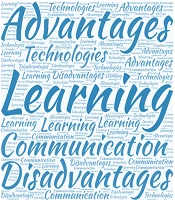1. Introduction
Electronic learning, traditionally known as e-learning, comprises learning through web-based materials, such as virtual classrooms and universities, which enable digital collaboration and distance learning with the help of technology. Impelled by the curiosity about this new mode of learning, the present review dwells at large on the advantages and disadvantages of e-learning as a new method of education.
The internet has evolved as one of the essential ways to make accessible resources for learning and investigation for both learners and instructors to attain and share information without attending didactic lectures, which used to be the modus operandi and the traditional mode of learning since the times of Plato and Socrates. Technology-based e-learning involves using the internet and other essential technologies to create materials for learning courses in an organization (1-3). E-learning is a part of scholars' learning in education in which learners study, learn, and get qualified online without attending college or university. Acquisition of knowledge has largely become online without students ever entering the portals of colleges and universities, and this mode of learning has been more or less in vogue in all institutions across the planet for almost two years during the COVID-19 era (4).
Investigating information systems reveals that users’ satisfaction is one of the essential factors in the success of system performance. Universities try to reach diverse objectives and outcomes, such as satisfaction, effectiveness, and student performance through e-learning. Nevertheless, many e-learning systems do not achieve their coveted and cherished goals (5). The application of modern communications and technologies for teaching and learning is increasing in institutions. Therefore, the advantages and disadvantages of e-learning as a new educational technique need to be explored and clarified. This article discusses the definitions of e-learning along with its benefits and weaknesses.
1.1. Advantages
Although E-learning may not be the most suitable option for education, it has several advantages, especially for higher educational institutions. For instance, e-learning compensates for the scarcities of academic personnel, including coaches or instructors, laboratory technicians, and staff. In addition, e-learning enhances knowledge efficiency and competency through easy access to the vast bulk of information (6). Distance education can be a suitable choice for achieving higher degrees without leaving their current job (7). Moreover, in distance learning, the learner can participate in the course available anywhere in the country, far away, and at times oceans away from their residential location. Even if an international institution offers the course, the course content can be easily accessed (8).
1.2. Disadvantages
The most common weakness of e-learning is the complete lack of substantial personal interactions between learners and educators, and colleagues. The face-to-face learning process in traditional education is much easier than in e-learning (9). When a student in traditional education needs to communicate with the educators about a lecture, it is generally relatively easy to talk to the teacher before or after the class. In distance learning, learners usually have more difficulty contacting their instructors. Although they can send an email, they certainly might not receive an immediate response compared to traditional learning. Therefore, problem-solving in the e-learning approach may be less efficient than in traditional learning methods (10).
E-learning exposes learners to distance as well as a lack of communication. As a result, very strong impetus and time management potentials are needed to reduce such effects (11). The possibility of dropping out and missing deadlines for any assignment is high due to the absence of face-to-face interaction and the lack of classmates who can help with persistent reminders about assignments. Consequently, if learners want to complete their distance education course, they must stay motivated and focused (7). Furthermore, e-learning is not appropriate for improving the socialization ability of instructors and the communication skills of learners. It restricts the role of instructors as supervisors in the educational process (6). In addition, the learners do not have the opportunity to practice the lessons orally (7). Although the learners may have high educational knowledge, they may not have the skills to present their knowledge socially (6).
Learning in an institution allows learners to interact with and meet people from diverse places on a personal level (7). In distance learning, the learners often study alone and, therefore, may feel solitary and miss the physical-social interaction in traditional courses. Lack of physical communication in the training process can cause many difficulties, such as isolation and depression (12, 13). It can be challenging to manage or control activities because proxies often monitor assessments and examinations in e-learning. Consequently, e-learning may also lead to an increased risk of plagiarism. Another disadvantage of e-learning is that not all disciplines can effectively use this type of education. For example, scientific specializations that need hands-on functional experience may be more challenging through e-learning. Research has shown that e-learning in the social sciences and humanities is more appropriate than in disciplines, such as medicine and engineering, where practical skills need to be developed.
E-learning can also result in congestion or overuse of some websites, resulting in unexpected costs in time and expenses (6). For instance, more time is needed to stare at digital screens (14). In addition, every student looking to enroll in a distance education program should finance several types of equipment, namely a computer, a webcam, and a constant internet connection. In general, it has been shown that 20% - 40% less effort and time is spent on traditional classrooms versus online courses (15). Many individuals believe that technical problems are the major obstacle to e-learning. The complex quality of technology limits online education only to learners familiar with computers and technology. In case of any software or hardware failure, the class session is interrupted because there is no physical communication between learners and instructors, which can disrupt the learning process. This over-reliance on technology is a significant drawback for e-learning (7, 16).
Furthermore, there is a risk that private companies in the labor market, as well as government employers, will not accept distance education degrees. Employers still prefer a certification from a traditional college to e-learning. They believe that e-learning is not yet a standard form of education (8). Other disadvantages of E-learning include the absence of body movement, reduced concentration, eye exhaustion, and the lack of personal discipline (14, 17).
2. Conclusion
Similar to any education, e-learning has advantages and disadvantages. E-learning will improve in the future, but there are still many debatable problems in this type of education to be investigated and clarified. Before learners register in any distance education program, it is best to carefully evaluate all the benefits and weaknesses to ensure they receive an education that satisfies their demands and professional goals.

